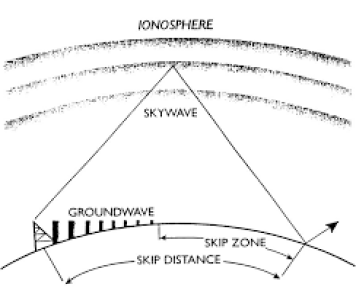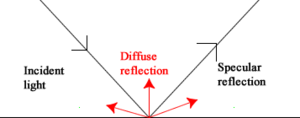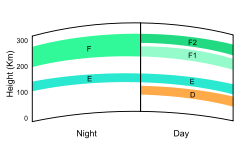Table of Contents
There are three main methods by which radio wave transmissions travel – light of sight, ground wave and sky wave.
Line of sight is the easiest mode of signal travel to understand, it’s simply a direct transmission from the transmitting antenna to the receiving antenna without relying on the signal travelling along either the ground or the sky. This means both antennas are oriented towards each other and have light of sight of each other.
Groundwave is when the radio transmission travels along the ground. Some radio waves are capable of “bending” around obstacles giving greater than line of sight transmission without relying on sky wave.

Skywave is when a radio transmission is bounced off the ionosphere (or the moon) and returned back to Earth. Skywave communication can achieve greater communications distances than groundwave by doing this because it isn’t blocked by terrain or the curvature of the Earth.
Most HF transmissions are a combination of groundwave and skywave. The skip zone (or dead zone) is the area where neither the groundwave signal nor the skywave signal are available. NVIS communication can be used to communicate with other operators in the skip zone. In general, the more vertical the orientation of the antenna, the smaller the skip zone will be because radio waves tend to return to earth at approximately the same angle as they’re transmitted.
Intuitively, then, this means that a shallower angle will result in a larger skip zone and a longer communications range while a deeper angle will result in a smaller skip zone and a shorter communications range. Practically, this means a communications range of a few hundred miles with a near vertical angle and a hemispheric (or larger) range with a shallower angle.
Misc key definitions and concepts
Attenuation is the gradual loss of radio signal strength.
Polarization is how the radio waves are oriented in their movement (more here).
Propagation is the behavior of radio waves as they travel from one point to another.
Terrain shielding is when a radio signal is blocked by terrain features.
More on Groundwave propagation
Generally you want a vertically polarized (perpendicular to surface of the earth) signal when using groundwave propagation. Generally the lower the frequency the more success you will find with groundwave propagation. Groundwave propagation can be blocked by mountains, the curvature of the Earth and man-made features. It is also attenuated by the ground itself as it travels. The higher the frequency, the more quickly the signal attenuates.
More on Skywave propagation
Skywave propagation is when a signal is reflected off the ionosphere (on more layers). Reflection can happen multiple times either reflecting over and over inside the ionosphere or reflecting back and forth between the Earth and the ionosphere. Skywave propagation is what makes long range radio communication (DXing) possible. The signal polarization doesn’t matter for skywave propagation and because of the randomness of the ionospheric reflection the signal can arrive at the receiver with any polarization.
Forms of Propagation
I currently understand five different forms of propagation: sporadic E, reflection, refraction, diffraction, backscatter and gray line.
Sporadic E propagation is an unpredictable form of propagation that occurs when ionized patches form inside the E layer of the ionosphere. [don’t worry; much more on the ionosphere later]. The result is that VHF signals, which would normally travel straight through the ionosphere, are instead reflected back down to Earth allowing for much longer range contacts than would normally be available. This makes VHF communication much more widely listenable.

Reflection is the easiest form of propagation to understand. The radio wave is simply, well, reflected back at an angle equal to what it was received in. Both terrain and the ionosphere can reflect radio waves.
Refraction is when a wave passes through condensed matter (like glass) and it changes direction. This can create a multi-path condition where the wave is split and travels along multiple paths.
Diffraction is when a wave travels around matter, such as when it travels around a tree or a building.
Backscatter is when a wave is reflected 180 degrees. This can happen when there’s a lot of dust or moisture in the air and is often most detectable when using strong signals. Because multiple “bounces” inside the ionosphere are possible, its sometimes possible for backscattered radio waves to land in the skip zone.
Grayline propagation takes advantage of the difference in the time it takes for the D and F layers of the ionosphere to deionize. Because the D-layer disappears more quickly than the F-layer, lower band transmissions in the gray line will propagate very strongly both north and south along the grayline. The grayline is the separation of night and day (dusk and dawn) that’s created along the Earth as it rotates. Think of it as the few hours of time where a part of the ionosphere has stopped receiving direct sunlight but has not yet had time to fully deionize.
Understanding and using the Ionosphere

The ionosphere is the uppermost part of the atmosphere surrounding the earth (more here). The lowest part of the ionosphere, the D layer, starts at about 90 kilometers above the surface of the earth. Conceptually, we understand the ionosphere as being divided into four layers during the day: D, E, F1, F2 and two layers at night: E, F. The e-layer is dumb and unpredictable and I don’t understand it yet. I don’t think the E-layer understands itself either.
The D-layer is quickly ionized by direct sunlight. This means that the D-layer quickly appears in the morning and grows throughout the day. After it loses direct sunlight at dusk it similarly de-ionizes and disappears equally quickly.
The F layer ionizes more slowly and splits into two layers, the F1 and F2 layers as it ionizes. The F layer is ionized by solar phenomena other than just direct sunlight . It’s slower to ionize in the morning and also stays ionized for longer after dark. The difference in ionization and deionization rates create the conditions needed for grayline propagation (see above).
The D-layer (“The Dick Layer”)
The D-layer is the “dick layer.” It absorbs radio signals, especially in the lower bands like 30m and lower. This makes reflection propagation on those bands nearly impossible during the day…because the D-layer is really the dick-layer. Still, it rarely manages to completely absorb the higher bands like 10m, 6m and 2m so you can use reflection propagation on those bands during daylight hours.
The D-layer is not without it’s utility though. Since it absorbs signals it means that the longer a signal travel travels through the d-layer, the more the signal attenuates. That means shallow angle transmitted signals attenuate more than deeper angle transmitted signals. It also means that as the d-layer grows thicker there’s more attenuation. Thus it will naturally have more impact on DXing than on NVIS. It will also help contain NVIS signals by attenuating any diffraction or backscatter along shallower angles.
This attenuation means there will be less noise during the day and that it’s easier to DX at night when weak signals won’t be attenuated by
The F-layer, F1 and F2 (“The Friend Layer”)
The F-layer sits above the D layer in the ionosphere. This means, obvious, signals must travel to through the D-layer to reach the friendly F-layer that helps us reflect signals back to Earth. During the daytime the F layer splits into the F1 and F2 layers as ionizes and condenses into a single thinner F-layer at night.
When the F layer is highly ionized during the day it’s easiest to reflect a signal off of and have it bounce back to earth. The F layer can even reflect signals as high in frequency as 10 MHz during periods of high ionization although lower frequency signals are easier to reflect.
Generally, the highest frequency you can get to refract will reflect best because you want to minimize the impact of D-layer attenuation. The critical frequency is the highest frequency that will reflect back to Earth and not pierce the F-layer and continue into space.
Skywave propagation rules of thumb
- Lower frequency/longer wavelength HF bands work best at night.
- High frequency/shorter wavelength HF bands work best during the day.
- 20m tends to work at both day and night in a mediocre way.
- 20m tends to be in the middle so the further you get from 20m the more pronounced the effects are.
UHF, VHF and HF propagation
UHF propagates by line of sight and is easily blocked by terrain (terrain shielding). The typical limit of a UHF transmission is at most 40 miles before it becomes attenuated.
VHF typically propagates by line of sight so it can be blocked by hills, mountains, buildings, rivers, etc. However these frequency bands do have some ability to refract which means they can travel outside the visual horizon, potentially upto about 100 miles or so. Because VHF can reflect and refract there is some potential and utility found in it transmitting over and around hills and other obstacles that would block UHF. 6m is particularly good at reflecting off and around hills, it even has some limited groundwave propagation abilities.
In the broadest possible terms, HF propagation tends to use Skywave and Groundwave. UHF and VHF (6m excluded) never uses Skywave propagation. This means that HF signals can he listened to and demodulated for extremely long distances lending itself to long range communications (see DXing and NVIS).
Urban terrain considerations with UHF and VHF
While VHF will travel further than UHF, the size of the wave matters as well. VHF waves are much larger than UHF waves which matters quite a bit when you’re dealing with commercial building constructed out of steel and concrete. Consider that a UHF wave is about 1.5ft and a VHF wave is 5ft or more. That means that a UHF signal can easily pass through doors, windows and between beams. A VHF signal can’t and will be reflected.
To whit, UHF may be a better choice in urban environments while VHF may be a better choice in outdoor environments.
Outdoor terrain considerations
The ground always attenuated RF signals so as signals travel along the ground they naturally become weaker as they travel. Vegetation also attenuates RF signals very well, especially moist vegetation. This can be either a benefit or a drawback for both groundwave and line of sight propagation.
Oceans and land with a lot of salt in it (salt flats, etc) will help groundwave propagation as they bounce signals very well with little attenuation. Wet clay soils are nearly as good. Dry rock and sand will attenuate signals.
For NVIS, being in a valley is more useful because you can reflect the signal off the sides of the valley forcing more of the signal upwards. For DXing, being at the top of the mountain is better.
Frequencies below 50 kHz can penetrate seawater with lower frequencies penetrating more. This is what submarines use. Above 30,000 kHz skywave propagation isn’t possible.